PROTECT YOUR DNA WITH QUANTUM TECHNOLOGY
Orgo-Life the new way to the future Advertising by AdpathwayConeflowers are attractive, long-blooming, hardy perennials that are native to North America. They’re loved for their easygoing nature, daisylike flowers, and value to pollinators and other wildlife. They find their place in all types of spaces and work exceptionally well in pollinator, prairie, and cottage gardens.
Caring for coneflowers is easy, making them a suitable choice for both novice and expert gardeners. With plenty of sun and well-drained soil, they should thrive. They require regular watering when newly planted, but once established, they are quite drought-tolerant.
These low-maintenance flowering perennials are a valuable and pleasing addition to the garden. While you can mostly leave them to their own devices, there are a few issues that could cause wilting coneflowers. Because they are so hardy, this can be disconcerting. Let’s discuss why your coneflowers are wilting and see if we can fix the problem.
The Short Answer
The most common reason for wilting coneflowers is related to watering. Both over- and underwatering, as well as poor drainage, can cause your plants to suffer. Other causes include stress from heat or transplanting, pest damage, and fungal diseases.
The Long Answer
Many of the factors that could be responsible for your wilting coneflower concern include watering habits and general moisture levels. Other reasons are predominantly linked to stress, which can originate from various sources. Let’s dig in.
Underwartering
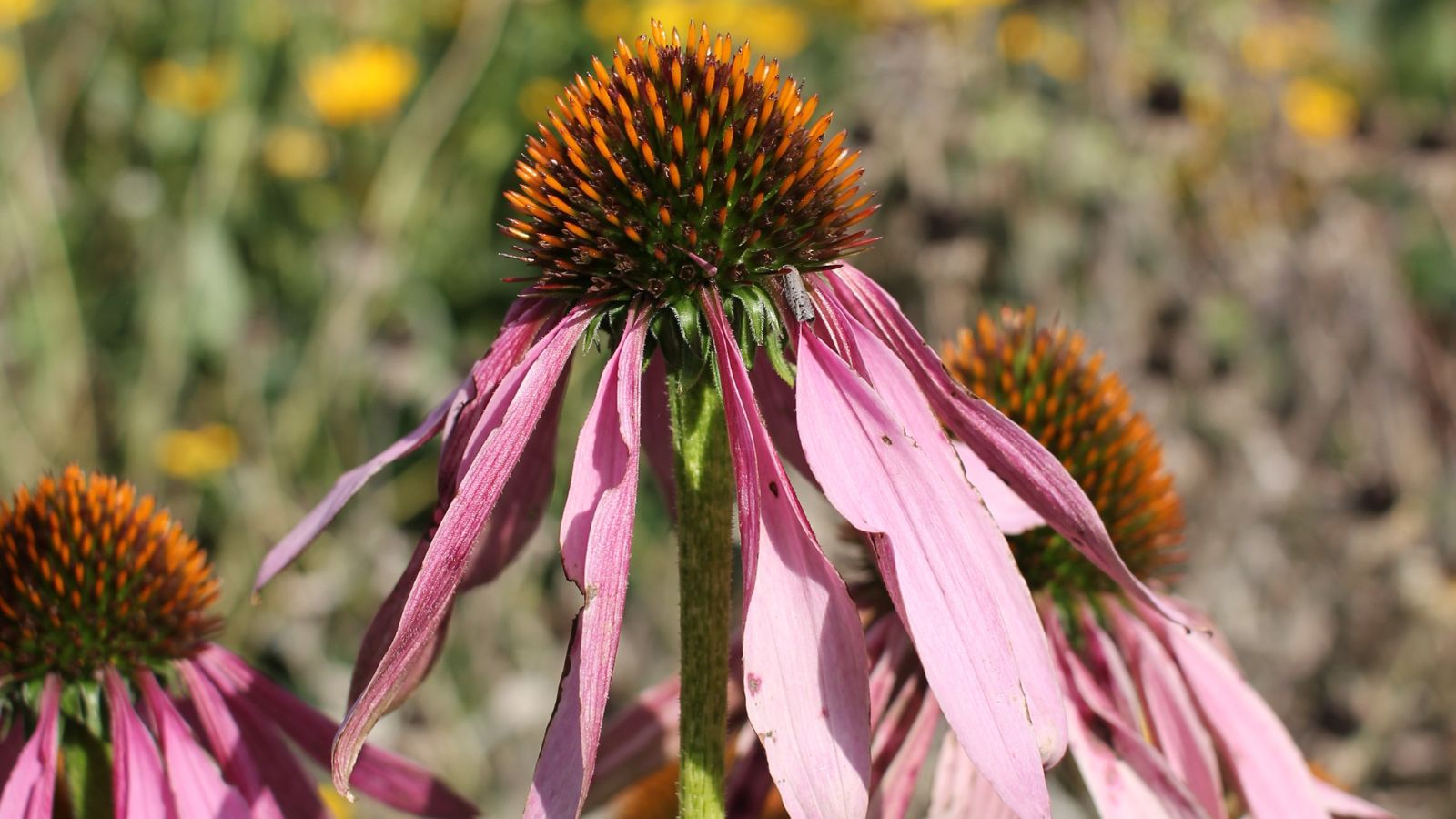 They are drought-tolerant, but dehydration can still affect them.
They are drought-tolerant, but dehydration can still affect them.Once established, coneflowers are quite drought-tolerant and resilient. However, like most plants, if they become dehydrated, they will show it by wilting. If your plant wilts during the day but perks up in the evening and looks good in the morning, underwatering might be the issue.
Other signs that your coneflower needs water are slowed growth, poor flower production, curling or brown leaves, and early flower drop. Check the soil about two inches below the surface. If it’s completely dry, you should give your plant a drink.
Going forward, during times of drought, water deeply but infrequently. It’s better to water deeply once a week than to give a little water every day. Deep watering promotes the development of deep, strong roots, resulting in a more resilient plant overall.
Always water at the base of the plant rather than overhead. This ensures that all the water reaches the roots, where it’s needed. Overhead watering deposits water on the foliage, where it’s not utilized, and can cause fungal issues.

Overwatering or Poor Drainage
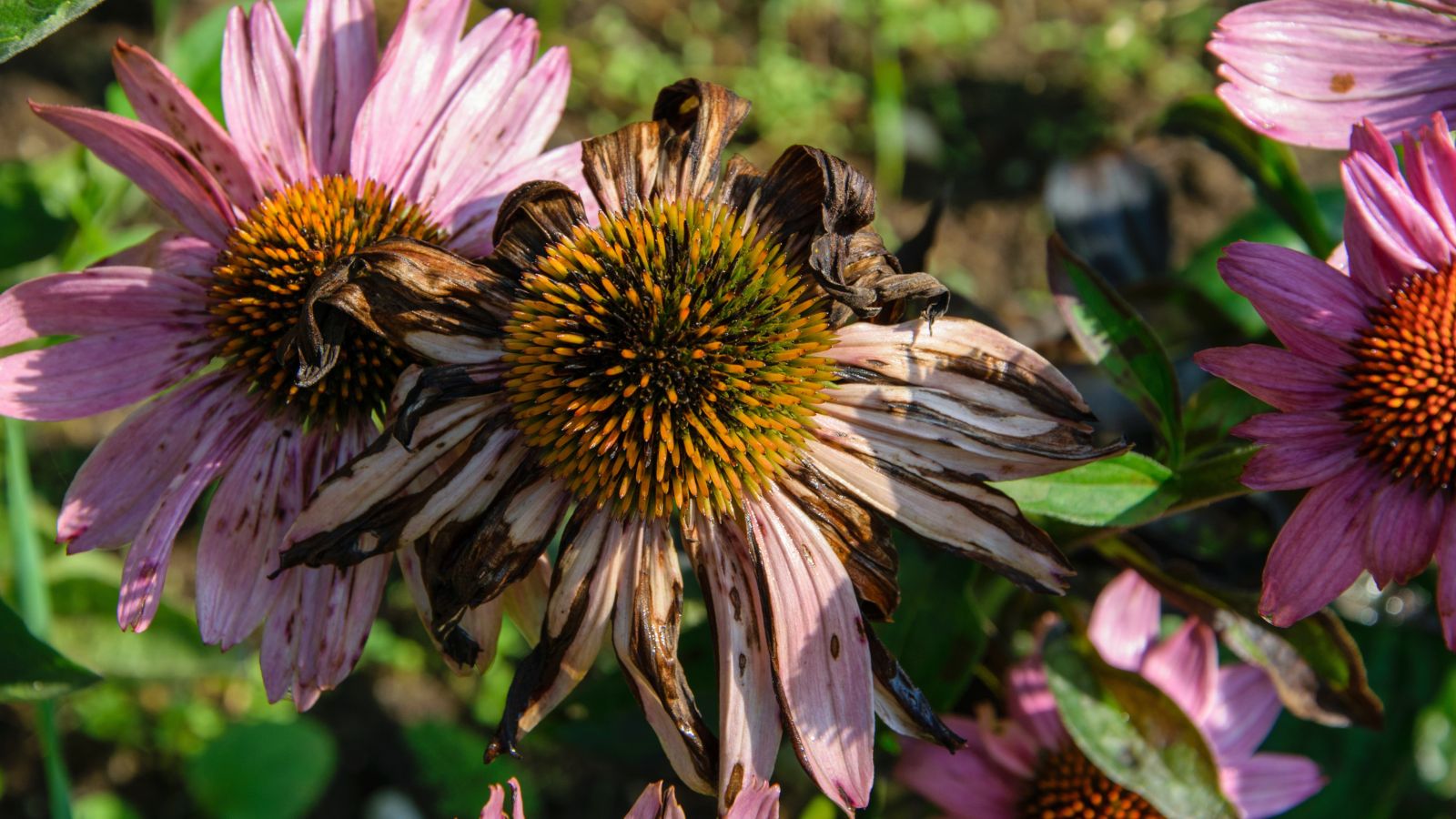 Poor drainage can prevent plants from taking up water.
Poor drainage can prevent plants from taking up water.If you’ve been providing enough water and still have a wilting coneflower, you may have the opposite problem. They need consistently moist soil when first planted. Through their first season, you may also need to water them. However, once established, they won’t require much water unless an extended period of drought occurs.
Overwatering or poor drainage can also cause wilted and sad-looking coneflowers. They are sensitive to wet soil, which can lead to root suffocation and the development of fungal diseases. The most common fungal diseases that cause wilting are crown or root rot.
Other signs of rot caused by overwatering include yellow leaves, stunted growth, and soft, mushy stems or crowns. If you get near the base of the plant and notice a foul smell, that’s also a strong indicator of root rot.
Because it’s difficult to diagnose root rot without seeing the roots, you’ll need to dig it up to be certain. Rotten roots will be dark and mushy, and they will come apart when handled. When the roots are rotten, they can’t take up water, so it mimics drought stress.
To prevent root rot, water sparingly, and most importantly, plant your coneflower in well-draining soil. Even in times of little rainfall, let the soil dry between waterings.
Aster Yellows Disease
 Asters yellows is incurable, so it’s best to remove infected plants.
Asters yellows is incurable, so it’s best to remove infected plants.Aster yellows is a disease caused by a phytoplasma called Candidatus Phytoplasma asteris. It’s transmitted by leafhoppers, especially the six-spotted aster leafhopper. It affects many plants in the Asteraceae family, including coneflowers.
Aster yellows can cause wilting and a general decline in plant health. Other symptoms to look for include deformed growth, yellow or pale leaves, and misshapen flowers with distorted central cones and twisted petals.
The bad news is that aster yellows are not treatable or curable, and your plant will not recover from it. The best course of action is to remove the plant and dispose of it properly. Don’t compost it or dispose of it near other susceptible plants.
Transplant Shock
 Relocating these wildflowers can result in shock and wilting.
Relocating these wildflowers can result in shock and wilting.If you’ve recently relocated your coneflower, and it’s suddenly wilted, it could be in shock. Any time you dig up a plant and move it to a new location, it will experience a certain amount of stress. It’s safe to expect this, so you won’t be shocked when it happens.
Transplant shock is usually temporary. With deep, consistent watering, your coneflower should perk up and start establishing new roots. It’s also important to transplant at the right time. Spring and fall, when the air is cooler, are ideal times for transplanting.
When transplanting, try to preserve as much of the root ball as possible. In other words, dig wider than you think, and you will avoid damaging the roots. Be gentle about digging up your plants to minimize shock.
To help your plant acclimate to its new location, watering is important. You can also trim back the plant to help it direct energy to root growth. Don’t fertilize right away, and if possible, give it some temporary shade. It takes between one and three weeks for transplant shock to resolve, so be patient.
Heat Stress
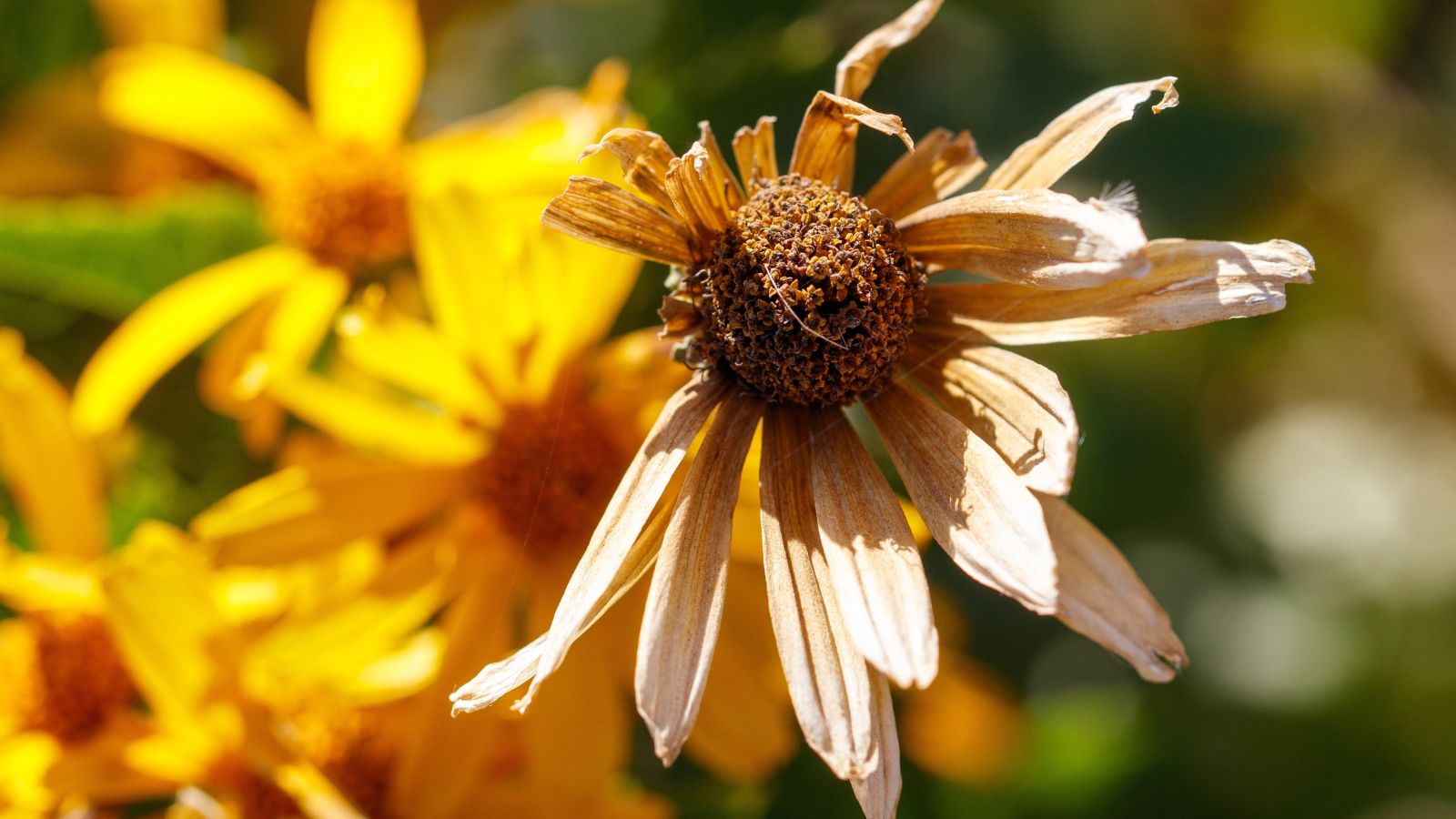 Extra high temperatures can cause petals to dwindle.
Extra high temperatures can cause petals to dwindle.Hand in hand with under-watering, heat stress can result in wilting coneflowers. This is more prevalent in newly planted coneflowers or those in poor and sandy soil that doesn’t hold moisture.
Heat stress causes wilting during the hotter hours of the day. It usually improves overnight, and you may notice it resolves by morning. The symptoms of heat stress are similar to those of underwatering. Leaves may droop and turn yellow, flowers may stop blooming or drop early, and foliage may turn brown and crispy.
If you suspect heat stress is to blame for your coneflower wilting, give it a long drink early in the morning. Mulch around the base to insulate and cool the roots. If you can, create a bit of shade for your coneflower during the hottest months. Trim off any scorched or brown foliage to give the plant energy to focus on new growth.
Avoid fertilizing during the hottest part of the summer. If you feel your plant needs some fertilizer, use a diluted liquid formula. If you give your plant extra care during the hotter months, it should recover and resume blooming.
Pest Infestation
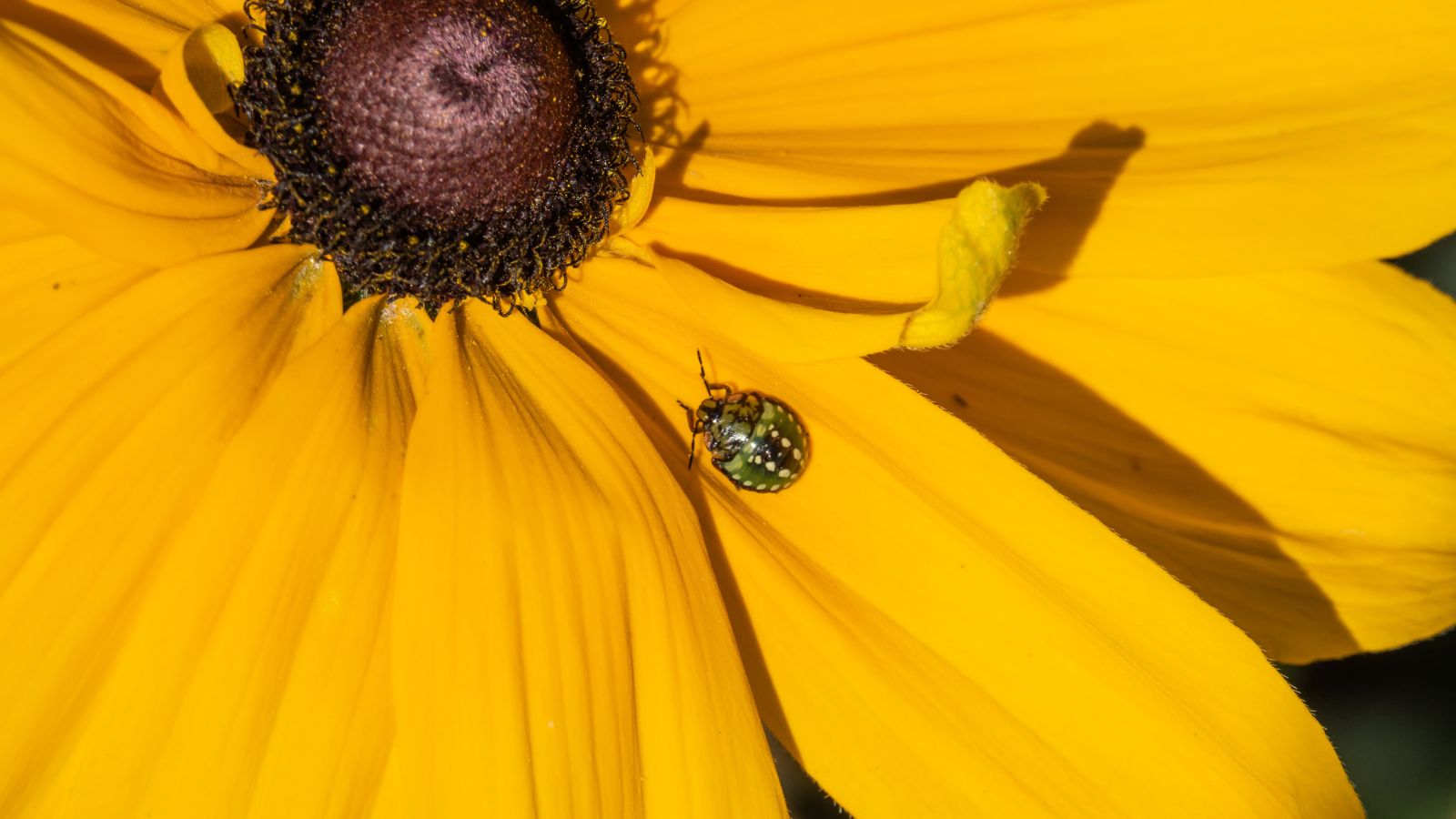 Visible insect infestations may require a natural spray like neem oil.
Visible insect infestations may require a natural spray like neem oil.Coneflowers, in general, are pest-resistant. Their tough leaves and bristly stems are undesirable to most chewing insects. It’s not unheard of, though, and wilting coneflowers can be the result of a pest infestation.
Sap-sucking insects like aphids, whiteflies, and mealybugs can contribute to dehydration. They also drain the plant of nutrients. Droopy, yellowing foliage, distorted growth, and sticky residue are signs of possible infestation.
Many insects are visible, although some, such as spider mites, are difficult to detect. Root-feeding grubs cause damage at the root level, resulting in sudden wilting and collapse. Squash bugs, stink bugs, and leafhoppers also suck sap and can cause stem collapse and localized wilting.
If you suspect insects are to blame, inspect your plant to determine the type. Most garden pests are treatable with neem oil, which is safer for people. Always spray in the evening when pollinators are not present. Coneflowers are highly attractive to pollinators, and neem oil can harm them when it’s wet.
If you have a heavily infested plant, the best course of action is to remove it altogether. As soon as those insects finish it off, they will move on to the next one, and then you have two suffering plants.
Key Takeaways
If you have a wilting coneflower, don’t panic. Chances are strong that it simply needs some water or a bit of shade. Although they are heat- and drought-tolerant, even these tough plants require a certain amount of moisture and heat protection. Overall, coneflowers are resilient and hardy, and once you identify the problem, they should recover quickly.


 2 days ago
7
2 days ago
7






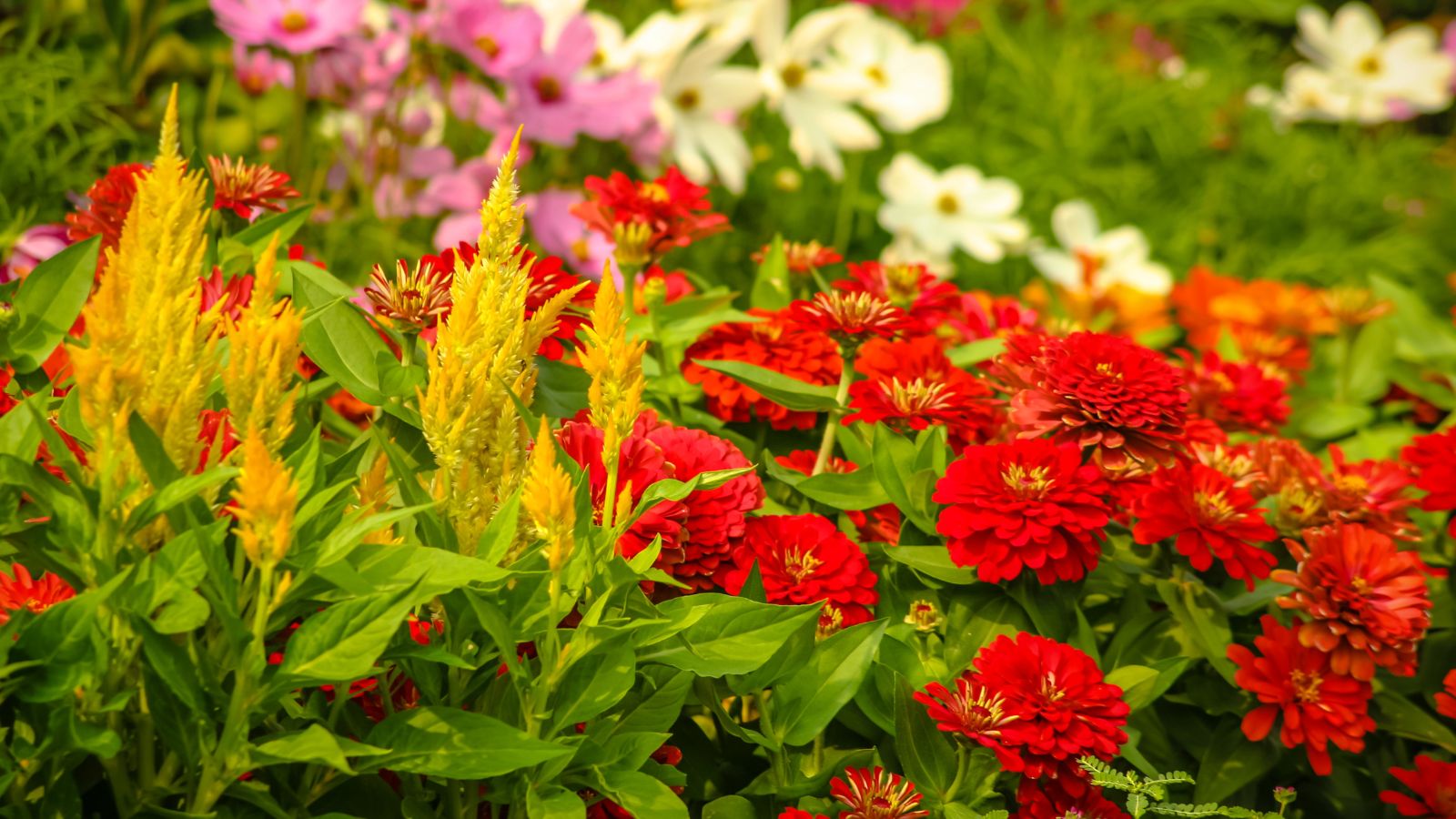














 English (US) ·
English (US) ·  French (CA) ·
French (CA) ·